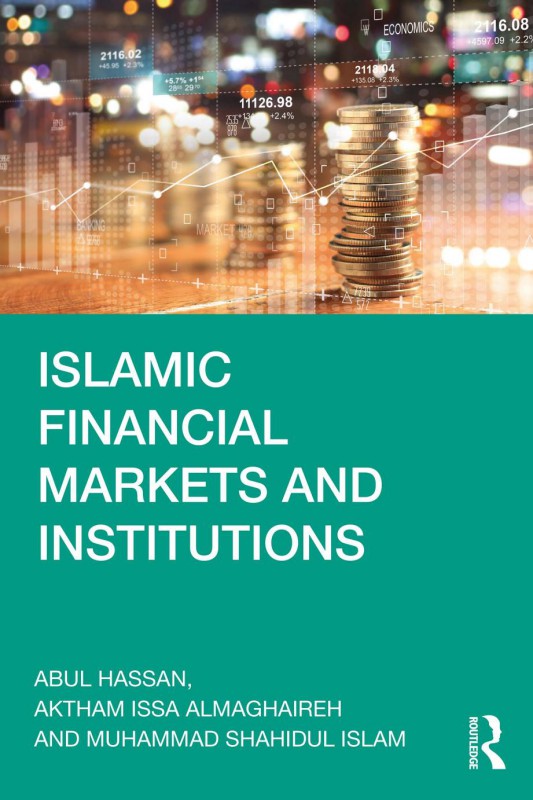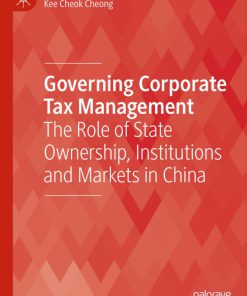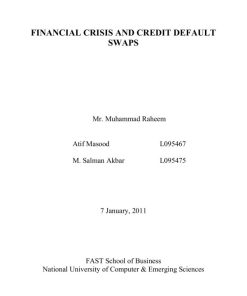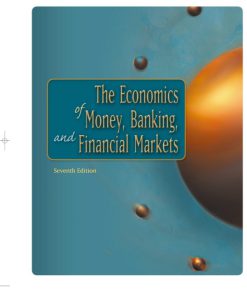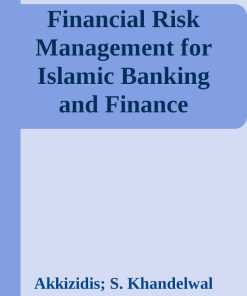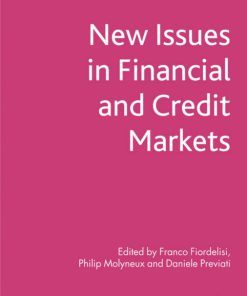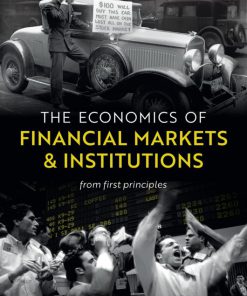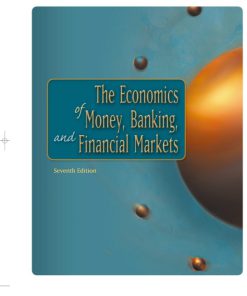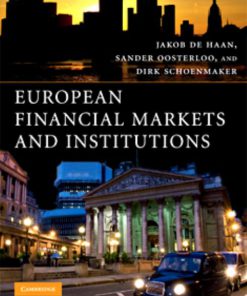Islamic Financial Markets and Institutions 1st Edition by Abul Hassan, Aktham Issa AlMaghaireh, Muhammad Shahidul Islam ISBN 9781000632934 1000632938
$50.00 Original price was: $50.00.$25.00Current price is: $25.00.
Authors:Abul Hassan , Series:Management [762] , Author sort:Hassan, Abul , Languages:Languages:eng , Published:Published:Jan 2023 , Publisher:Routledge , Comments:Comments:The rapid pace of progress in the Islamic financial market and investment space, coupled with the COVID-19 pandemic and its aftermath and recovery, has provided the necessary challenges to build a strong case for Islamic investment. This timely and unique book focuses on the foundations of Islamic financial markets and institutions in the context of various products, their market application, Islamic asset management, and regulation.The authors provide a thorough overview of Islamic financing instruments and markets, such as Islamic debt and equity markets, through shares and the stock market, mutual funds, private equity, lease financing, Sukuk, green Sukuk, money market instruments, exchange-traded funds, cryptocurrencies, derivatives and so forth, which have emerged as alternative sources of financing. They offer insight into the numerous infrastructure institutions which have sprung up since the first decade of the new century, such as the Accounting and Auditing Organizations for Islamic Financial Institutions, Islamic Financial Services Board, Islamic International Rating Agency, and International Islamic Liquidity Management Corporation, as well as those being established, to satisfy different industry needs.With its uniquely competitive approach to the mainstream financial market, this book facilitates a greater understanding of the concept of Islamic investment. Through a discussion of the current state and future prospects of Islamic financial markets, the book’s theoretical and practical approach offers academics, practitioners, researchers, students, and general readers a well-balanced overview of Islamic financial markets, its ethics, Shari’ah foundation, the instruments and operational mechanism used by Islamic capital, money, and debt markets.
Islamic Financial Markets and Institutions 1st Edition by Abul Hassan, Aktham Issa AlMaghaireh, Muhammad Shahidul Islam – Ebook PDF Instant Download/Delivery. 9781000632934 ,1000632938
Full download Islamic Financial Markets and Institutions 1st Edition after payment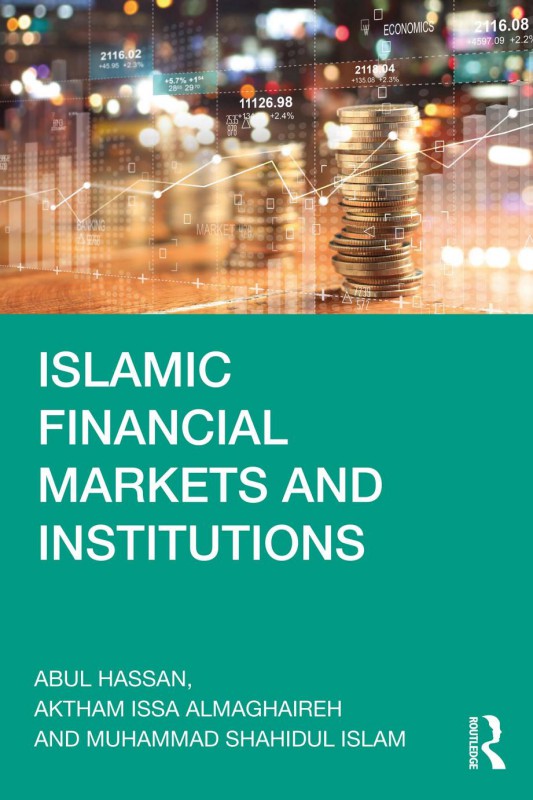
Product details:
ISBN 10: 1000632938
ISBN 13: 9781000632934
Author: Abul Hassan, Aktham Issa AlMaghaireh, Muhammad Shahidul Islam
Islamic Financial Markets and Institutions 1st Edition Table of contents:
1 Understanding Principles and Concepts of Islamic Finance
1.1 Introduction
1.1–1 Islamic Finance Principles
1.1–2 Islamic Financial Practice
1.1–3 What Does Islamic Finance Stand For?
1.2 The Components of Islamic Finance
1.2–1 Banking and Riba (Interest)
1.2–2 Islamic Banking
1.2–3 Takaful (Islamic Insurance)
1.2–4 Islamic Capital Markets
1.3 The Principal Features of Islamic Finance
1.3–1 Interest Free
1.3–2 The Need for Underlying Assets
1.3–3 Avoiding Uncertainty or Gambling
1.3–4 Profit and Loss Sharing
1.3–5 Shari’ah Based
1.4 Why Islamic Finance?
1.4–1 The Benefits of Islamic Finance
1.4–2 What Does Islamic Finance Offer?
1.4–3 Profit and Loss Sharing
1.5 Real Assets Over Monetary Assets in Islamic Finance
1.6 Major Contracts Used in Islamic Finance
1.6–1 Mudarabah (Trust Financing)
1.6–2 Musharaka (Profit and Loss Sharing Joint Venture)
1.6–3 Murabahah (Cost Plus)
1.6–4 Ijarah (Leasing)
1.6–5 Istisna (Manufacturing an Asset)
1.6–6 Salam (Advance Payment Sale)
1.6–7 Wadiah (Safekeeping)
1.6–8 Wakalah (Agency)
1.7 Conclusion
2 Primary and Secondary Markets
2.1 Introduction
2.1–1 Primary Market
2.1–2 Secondary Market
2.2 Bull and Bear Markets
2.3 Short Selling
2.4 Two Basic Strategies: Value Investing and Growth Investing
2.5 Conclusion
3 Islamic Capital Market
3.1 Introduction
3.2 Products in ICM
3.3 Classification of the Islamic Capital Market
3.4 Understanding Shari’ah Screening
3.4–1 Screening Methodology
3.4–2 Shari’ah Stock Screening
3.4–3 Screening Business Activities
3.4–4 Qualitative and Quantitative Screening Criteria
3.5 Flow of Funds in the Islamic Capital Market
3.6 Liquidity Issues in the Islamic Capital Market
3.7 Regulatory and Legal Frameworks of the Islamic Capital Market
3.8 Conclusion
4 Islamic Equity Markets
4.1 Introduction
4.2 Types of Islamic Equity
4.2–1 Mudarabah Products
4.2–2 Musharaka Products
4.3 Shari’ah Recognise the Joint-Stock Companies and Trading of Shares in the Secondary Market
4.3–1 Islamic Investment Funds
4.3–2 Shari’ah-Compliant Stocks
4.3–3 Islamic Mutual Funds
4.3–4 Mixed Islamic Funds
4.3–5 Islamic Assets Under Management
4.3–6 Growth in Islamic Funds Assets
4.4 Characteristics of Islamic Equity
4.5 Islamic Equity Market Indexes
4.5–1 Relative Performance of Islamic and Conventional Indexes
4.5–2 Significance of Islamic Equity Investments
4.6 Price and Valuation of Equity
4.6–1 Using Price-to-Earnings Ratio to Evaluate Stock
4.6–2 Price-to-Earnings Ratio and Return on Equity
4.6–3 Price-to-Book Ratio and Return on Equity
4.6–4 Return on Equity
4.6–5 Equity Value and Enterprise Value
4.6–6 Difference Between Market Value of Equity and Book Value of Equity
4.6–7 Basic Equity Value Versus Diluted Equity Value
4.7 Understanding Measuring of Risks
4.7–1 Classifications of Risks
4.7–2 Common Measures of Risk
4.8 Can Screening of Islamic Stocks Induce Another Risk for Investors?
4.9 Conclusion
5 Investment in Islamic Mutual Funds: A Vehicle for Mobilisation of Small Savings
5.1 Introduction
5.2 Types of Islamic Mutual Funds
5.3 Calculation of Net Asset Value in Islamic Mutual Funds
5.3–1 Swing Pricing
5.3–2 Difference Between Swing Pricing and Fair Value Pricing
5.4 Islamic Investment Criteria
5.4–1 Qualitative Screens
5.4–2 Quantitative Screens
5.5 Trading and Investing Practices
5.6 Growing Importance of Islamic Mutual Funds
5.7 Investment Process of Islamic Mutual Funds
5.8 Asset Growth and Investment Allocation
5.9 Comparative Performance of Islamic and Conventional Indices
5.10 Conclusion
6 Investment in Islamic Private Equity
6.1 Introduction
6.2 Venture Capital Versus Private Equity
6.3 Structuring Islamic Private Equity
6.4 Deal and Shari’ah Screening Process
6.5 Choice of Investment in Islamic Private Equity
6.5–1 Direct Investment
6.5–2 Fund of Funds
6.5–3 Private Equity Funds
6.6 Factors of Benefit From Islamic Private Equity
6.6–1 Continuing Convergence
6.6–2 Delivering
6.6–3 Activating
6.7 Growth of Islamic Private Equity
6.8 Prospects of Islamic Private Equity in the Global Markets
6.9 Conclusion
7 Capital Asset Pricing Model in the Shari’ah Domain
7.1 Introduction
7.1–1 Efficient Frontier
7.1–2 Disadvantages of CAPM
7.2 Previous Studies on CAPM in the Shari’ah Domain
7.3 Shari’ah Viewpoints on the Assumption of Traditional CAPM
7.3–1 No Operation Cost
7.3–2 No Personal Income Tax
7.3–3 Divisibility and Saleability of Asset
7.3–4 Investors’ Choices Are Exclusively in Terms of Variance (Risk) and Expected Return
7.3–5 Short Sales Violate Islamic Ethics
7.3–6 Homogeneousness of Expectation
7.3–7 Unrestricted Borrowing and Lending at a Risk-Free Rate
7.3–8 A Financier Should Not Change the Price of a Stock by Buying and Selling Activities
7.4 Traditional CAPM Undesirable in Islamic Finance
7.5 The Proposed CAPM in the Islamic Domain
7.6 Benefits of the Shari’ah-Compliant Model in Contrast With the Traditional CAPM
7.7 Conclusion
8 Islamic Exchange-Traded Funds
8.1 Introduction
8.2 Common Type of ETFs
8.2–1 Equity ETFs
8.2–2 Bond/Fixed Income ETFs
8.2–3 Commodity ETFs
8.2–4 Currency ETFs
8.2–5 Specialty ETFs
8.3 Factors Investing in ETFs
8.3–1 ETF Creation and Redemption
8.3–2 Not Free From Risk
8.4 Process of ETF
8.5 Islamic Exchange-Traded Funds
8.5–1 Financial Ratio Screening
8.6 Tracking a Shari’ah-Compliant Index
8.6–1 Compliance With Shari’ah Principles for Gold, Silver and Currencies
8.7 Islamic EFTs in the Global Market
8.8 Islamic ETFs in Comparison
8.9 Return Comparison of Islamic ETFs
8.10 Cases of Three US-Based Halal ETFs
8.11 Conclusion
9 Islamic Real Estate Investment Trusts
9.1 Introduction
9.2 How Do REITs Operate?
9.3 Kinds of REITs
9.3–1 Types of REITs on the Basis of Investment Holdings
9.3–2 Types of REITs on the Basis of Trading Status
9.3–3 Private REITs
9.4 Islamic Real Estate Investment
9.5 Shari’ah Guidelines for Real Estate Investment Trusts
9.5–1 Features That Define Islamic REITs
9.6 Contracts in Islamic REITs
9.7 Prohibitions in REITs Under Shari’ah
9.8 Development of Global Sharia-Compliant REITs
9.8–1 GCC’s Shari’ah-Compliant REITs
9.8–2 Malaysian Shari’ah-Compliant REITs
9.8–3 Singaporean Shari’ah-Compliant REITs
9.8–4 The United Kingdom and the Middle East and North Africa
9.8–5 REITs in the United States
9.8–6 A Case Study: Manulife Shari’ah Global REIT Fund
9.9 Conclusion
10 Financial Futures, Stock Options, and Warrants in the Islamic Capital Market
10.1 Introduction
10.2 Stocks and the Islamic Capital Market
10.3 Strategies for Sophisticated Conventional Investors: Stock Options, Warrants and Futures
10.3–1 Options
10.3–2 Warrants
10.3–3 Futures Contracts
10.4 Shari’ah Prohibits Maisir, Gharar and Dayn bi-dyan
10.5 Obstacles Encountered During the Practice of Stock Index Futures, Stock Options and Warrants in the Islamic Market
10.5–1 Stock Index Futures
10.5–2 Stock Options
10.5–3 Warrants
10.6 Conclusion
11 The Islamic Money Market Vis-à-Vis the Conventional Money Market
11.1 Introduction
11.2 Conventional Money Market Yields
11.3 Conventional Money Market Rates
11.3–1 Discount Rates
11.3–2 Add-on Rates
11.4 Comparison of Money Market Instruments Using Bond Equivalent Yield
11.5 Islamic Money Markets
11.5–1 Functions of the Islamic Money Market
11.5–2 Safeguard of Liquid Assets
11.6 Islamic Money Market Instruments Experienced in Some Muslim Countries
11.6–1 Islamic Interbank Money Market in Malaysia
11.6–2 Islamic Interbank Money Market in Bahrain
11.6–3 Islamic Interbank Money Market in Pakistan
11.7 Conclusion
12 Sukuk Securities: New Ways of Debt Contracting
12.1 Introduction
12.2 Sukuk Structuring
12.2–1 Popular Types of Structured Sukuk
12.3 Global Sukuk Market Performance
12.3–1 Short-Term Sukuk
12.3–2 Composition of International Long-Term Sukuk Issuance
12.4 Challenges to the Development of the Sukuk Market
12.4–1 Legal Regime
12.4–2 Standardisation
12.4–3 Mechanics for Default
12.5 AAOIFI’s Concern on Shari’ah Compliance of Sukuk
12.6 Conclusion
13 Green Sukuk Vis-à-Vis Green Bonds
13.1 Introduction
13.1–1 Types of Green Bonds
13.1–2 Type of Projects of Green Bond Investment
13.1–3 Green Bonds Issuers
13.1–4 Themes of Green Bond Investment
13.2 Green Sukuk
13.2–1 Difference Between Green Islamic Bonds and Green Bonds
13.2–2 Method of Issuance of Green Sukuk
13.2–3 Eligible Projects Under the Green Sukuk Framework
13.2–4 Demand for Green Sukuk
13.2–5 External Reviewers
13.2–6 Impact Reporting
13.3 Global Green Sukuk Market Trend
13.3–1 Case Study
13.4 Challenges and Opportunities
13.4–1 Marginal Market
13.4–2 Unclear Benefit
13.4–3 Lack of Supply
13.4–4 Costly in the Process of Issuance
13.4–5 Opportunities
13.5 Conclusion
14 The Basel Standards in Relation to Islamic Finance as an International Regulatory Framework
14.1 Introduction
14.2 Basel Accord Application in Islamic Banks and Financial Institutions
14.2–1 Capital Adequacy Framework Under the Basel Accord
14.3 Basel Methodology to Islamic Banking and Finance
14.3–1 AAOIFI Capital Adequacy Framework
14.3–2 The IFSB Capital Adequacy Framework
14.4 Risk Specification of IFIs
14.4–1 Risk Specification in IFSB Guidelines
14.4–2 Liquidity Risk in Basel III Framework
14.5 Conclusion
15 Cryptocurrency: Shari’ah-Compliant Digital Currency
15.1 Introduction
15.2 Economic Significance of Cryptocurrency
15.2–1 Importance of Cryptocurrency
15.2–2 The Value of Cryptocurrency
15.2–3 Cryptocurrency Wallets
15.3 Blockchain and the Operational Method
15.4 Electronic Cash and Digital Payment
15.4–1 Bitcoin
15.4–2 Ethereum (ETH)
15.4–3 Litecoin
15.4–4 Cardano (ADA)
15.4–5 Binance Coin (BNB)
15.4–6 Tether (USDT)
15.4–7 XRP (XRP)
15.4–8 Solana (SOL)
15.4–9 Polkadot (DOT)
15.4–10 Dogecoin (DOGE)
15.4–11 USD Coin (USDC)
15.4–12 Uniswap (UNI)
15.4–13 Terra (LUNA)
15.4–14 Libra
15.5 Digital Payments
15.6 Do Cryptocurrencies Signify Real Money?
15.7 Legal Status of Cryptocurrency
15.8 Risk Involved in Trading Cryptocurrencies
15.9 Islamic Legal Criteria on Money and Commodity
15.10 Unit of Account Differences Between Money and Commodities
15.11 Are Cryptocurrencies Shari’ah Compliant?
15.12 Conclusion
16 Financial Technologies in Islamic Finance
16.1 Introduction
16.2 Islamic FinTech
16.2–1 Key Areas for Islamic FinTech
16.2–2 Islamic Finance Vis-à-Vis FinTech
16.3 Islamic FinTech Landscape
16.3–1 Islamic FinTech Categories and Platforms
16.4 Islamic FinTech Application in Blockchain
16.4–1 Goldmoney Inc
16.4–2 Blossom Finance
16.4–3 Finterra
16.5 Islamic Robo Advisors
16.5–1 Wahed Robo Advisor
16.5–2 Algebra
16.5–3 Aghaz Investments
16.5–4 Others
16.6 Case Studies
16.6–1 Founding Principles
16.6–2 Value Proposition
16.6–3 Traction to Date
16.6–4 Roadmap for the Future
16.7 Risks of Islamic FinTech and Potential Mitigations
16.8 Conclusion
17 International Islamic Accounting Standard-Setting Body (AAOIFI)
17.1 Understanding the AAOIFI
17.2 Conclusion
18 International Islamic Financial Services Board (IFSB)
18.1 Introduction
18.2 Constituent Members
18.3 Adoption of Standards
18.4 Conclusion
19 Islamic International Rating Agency (IIRA)
19.1 Introduction
19.2 Type of Ratings Offered by IIRA
19.2–1 Sovereign Ratings
19.2–2 Issuer Ratings
19.2–3 Sukuk Ratings
19.2–4 Shari’ah Quality Ratings
19.2–5 Corporate Governance Ratings
19.3 Conclusion
20 International Islamic Liquidity Management Corporation (IILM)
20.1 Introduction
20.2 Diverse Membership and International Recognition
20.3 Islamic Liquidity Management Tool
20.4 Conclusion
21 Conclusion: Future of Islamic Financial Markets
21.1 Introduction
21.2 Growth Outlook
21.3 Islamic Finance Increases Market Share
21.3–1 Growth of Mergers and Acquisitions
21.3–2 Islamic Funds
21.3–3 Islamic Real Estate
21.3–4 Sukuk
21.3–5 ESG in Islamic Finance
21.3–6 Islamic FinTech
21.3–7 Shari’ah Governance
21.4 Challenges Faced by Islamic Finance
21.5 Future Opportunities for Growth
Index
People also search for Islamic Financial Markets and Institutions 1st Edition:
what is islamic financial institutions
what are financial markets and institutions
islamic financial institutions in usa
islamic financial advisor near me
You may also like…
eBook PDF
Financial Crisis and Credit Default Swaps 1st Edition by Muhammad Raheem, Atif Masood, Salman Akbar

